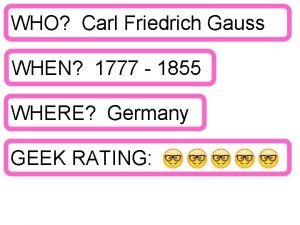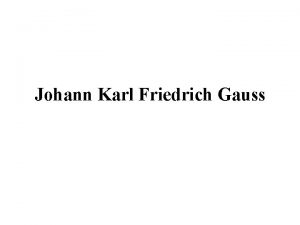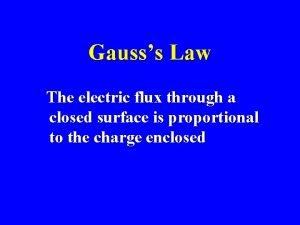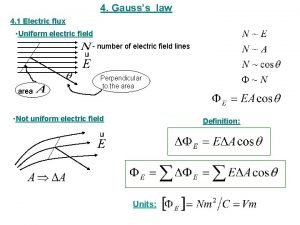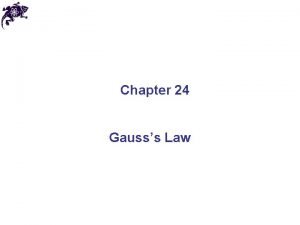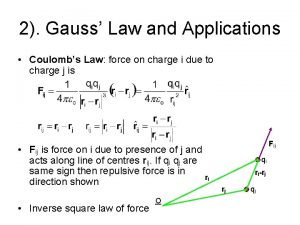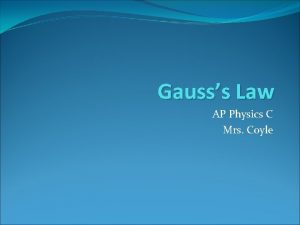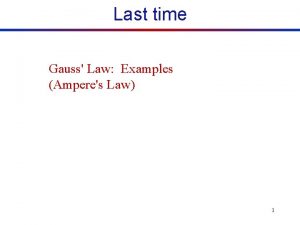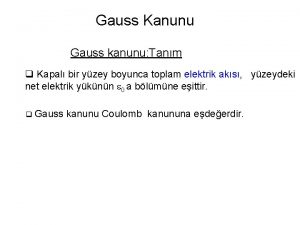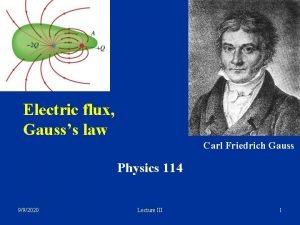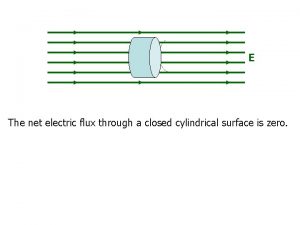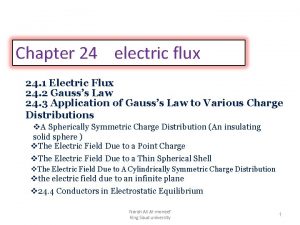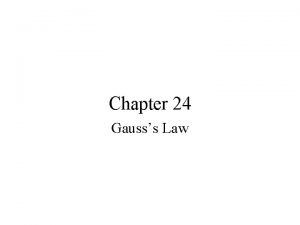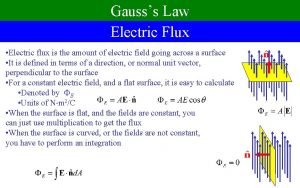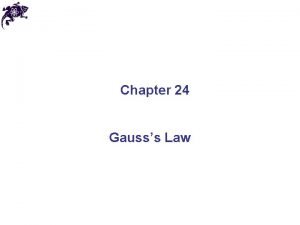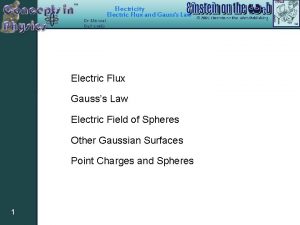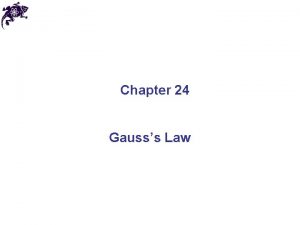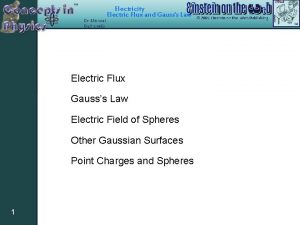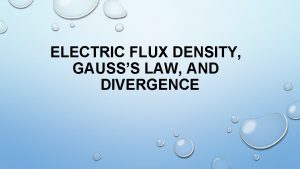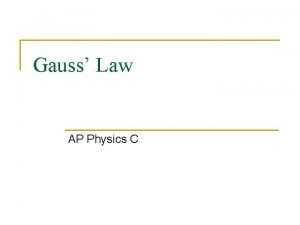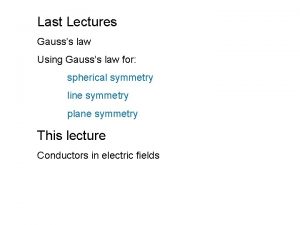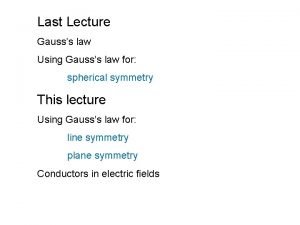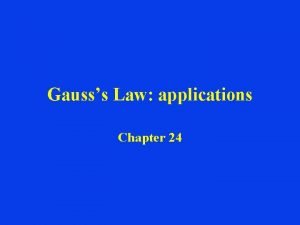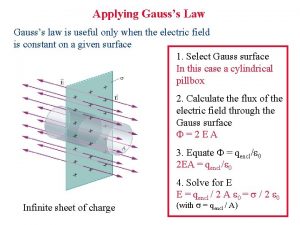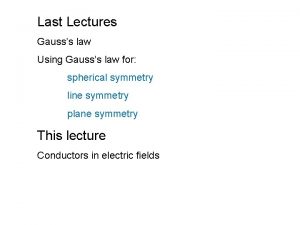Electric flux Gausss law Carl Friedrich Gauss Physics




















- Slides: 20

Electric flux, Gauss’s law Carl Friedrich Gauss Physics 114 9/9/2020 Lecture III 1

Concepts • Primary concepts: – Electric flux 9/9/2020 Lecture III 2

Laws • Gauss’s law 9/9/2020 Lecture III 3

Definition of electric flux • Flux means flow • Nothing is actually flowing • Other than that thinking of flow really helps to understand the flux 9/9/2020 Lecture III 4

Electric flux • If electric field is rain – electric flux is the amount of water in a bucket accumulated per unit of time: • Only component of the field perpendicular to the area A contributes to the flux 9/9/2020 Lecture III 5

Electric flux • Alternatively we can define a vector A, which equals to the area A and is directed perpendicularly to the area Flux is proportional to the number of field lines going through the surface 9/9/2020 Lecture III 6

Compare fluxes 2 1 Which flux is larger? 1). F 1>F 2 2). F 1<F 2 9/9/2020 Lecture III 3). F 1=F 2 7

Compare fluxes 2 1 Which flux is larger? 1). F 1>F 2 2). F 1<F 2 9/9/2020 Lecture III 3). F 1=F 2 8

Compare fluxes 1 2 Which flux is larger? 1). F 1>F 2 2). F 1<F 2 9/9/2020 Lecture III 3). F 1=F 2 9

Compare fluxes 1 2 Which flux is larger? 1). F 1>F 2 2). F 1<F 2 9/9/2020 Lecture III 3). F 1=F 2 10

Compare fluxes 1 2 Which flux is larger? 1). F 1>F 2 2). F 1<F 2 9/9/2020 Lecture III 3). F 1=F 2 11

Compare fluxes 2 1 Which flux is larger? 1). F 1>F 2 2). F 1<F 2 9/9/2020 Lecture III 3). F 1=F 2 12

Non-uniform field, irregular surface • Closed surface • Influx <0 • Outflux>0 9/9/2020 Don’t worry, we’ll only deal with simple surfaces Complex surfaces can be handled using numeric integration by a computer. Lecture III 13

Why do we need flux? • Gauss’s law: 9/9/2020 Lecture III 14

Gauss Coulomb • Calculate E of point like (+) charge Q • Consider sphere radius r centered at the charge • Spherical symmetry: E is the same everywhere on the sphere, perpendicular to the sphere 9/9/2020 Lecture III 15

Sinks and sources • What goes in – goes out • unless • there is a source (positive charge) + • or a sink (negative charge) 9/9/2020 Lecture III 16

What’s the flux? • F 1=? 9/9/2020 F 2=? Lecture III 17

Respect the symmetry • Find electric field for the following configurations: • Uniformly charged sphere. Charge Q, radius R. • Long uniform line of charge. Charge per unit length l. • Infinite plane of charge. Charge per unit of area s 9/9/2020 Lecture III 18

Field near conductor • Infinite plane of charge. Charge per unit of area s • Field inside conductor is zero, outside perpendicular to the surface. 9/9/2020 Lecture III 19

Two parallel plates • Infinite plates • One positive, one negative, • Same charge density s + 9/9/2020 Lecture III 20
 Carl friedrich gauss formula
Carl friedrich gauss formula Carl friedrich gauss 1777 1855
Carl friedrich gauss 1777 1855 Karl friedrich gauss
Karl friedrich gauss Biografia de johann carl friedrich gauss
Biografia de johann carl friedrich gauss Conclusion of gauss law
Conclusion of gauss law Gausss law
Gausss law Electrostatic equilibrium
Electrostatic equilibrium Coulomb's law integral
Coulomb's law integral Carl friedrich von weizsäcker vorhersage
Carl friedrich von weizsäcker vorhersage Physics gauss law
Physics gauss law Gauss law physics classroom
Gauss law physics classroom Gauss law ap physics c
Gauss law ap physics c Hysteresis loop magnetism
Hysteresis loop magnetism Weber magnetism
Weber magnetism Ampere's law example
Ampere's law example Derive coulomb's law from gauss law
Derive coulomb's law from gauss law Row operation
Row operation Eliminasi gauss dan gauss jordan
Eliminasi gauss dan gauss jordan Carl flux
Carl flux Electric flux formula
Electric flux formula Electric field inside sphere
Electric field inside sphere
